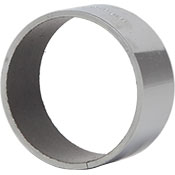A bushing’s load and dynamic speed condition create heat through high surface interaction that generates friction. Heat, if not properly adjusted, will cause a bearing to fail.
Lubrication is the key element in controlling bushing friction and providing an adequate design life. In essence, it allows the bearing system to survive.
Where PTFE Bushings Excel
A variety of bushings are available to fight increased temperature or lubrication-starved conditions that lead to failure. Remarkably, the most common approach involves a grease-free method of design. Self-lubricating, metal-backed PTFE bushings are often chosen as the number one solution to ending lubrication issues.

PTFE bushings:
- Operate dry
- Provide unique friction characteristics
- Allow necessary efficiency to reduce heat at high loads
- Lower maintenance costs
- Extend application service life
PTFE is also a more attractive solution because it eliminates containments associated with greasing. When greasing or re-greasing a bushing, excess grease attracts dust and other contaminants which reduce the service lifetime of metal bushings.
Selecting the proper type of lubrication in a bearing system such as oil, grease or self-lubricating PTFE bushing composites can be a very complex undertaking from the design standpoint and considering the sophistication of the application conditions.
